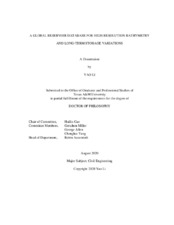| dc.description.abstract | Reservoirs play a significant role in water management, with functions related to water supply, hydropower generation, flood protection, and biodiversity conservation. To operate reservoirs efficiently for maximum benefit, it is essential to monitor their characteristics and states. Satellite remote sensing provides the unique advantage of observing reservoirs from space. In this dissertation, a series of algorithms was developed to generate high-resolution 3-D bathymetry maps and long-term storage records at a global scale, which can support a variety of applications such as global hydrological modeling and local water resources related studies. These algorithms and datasets are presented through the following three studies:
(1) In the first study, an algorithm was developed to generate 3D reservoir bathymetries by combining elevations collected by the Ice, Cloud, and Land Elevation Satellite (ICESat-2) airborne prototype with area values from Landsat-based water classifications (from 1982 to 2017). Validations over four transects of Lake Mead show R2 values ranging from 0.82 to 0.99 and Root Mean Square Error (RMSE) values from 1.18 m to 2.36 m. It is expected that the newly launched ICESat-2 should enable the derivation of bathymetries over an unprecedented number of reservoirs.
(2) The bathymetry generation algorithm was then applied to satellite altimetry and imagery observations to generate a global dataset for 347 global reservoirs. This dataset represents a total volume of 3123 km3, accounting for 50% of the global reservoir capacity. Validations over 20 reservoirs indicate that the dataset has an overall good accuracy. It suggests that this approach can also be applied to small reservoirs (with surface areas of a few square kilometers or less) and natural lakes.
(3) In the last study, multi-source remote sensing data—in combination with an improved area-depth-storage database—were used to estimate the monthly storage variations for 7245 reservoirs globally from 1999 to 2018. Results show that there is an overall continuous increase of global reservoir total storage at a rate of 27.44 ± 0.96 km3/yr, which is attributed to the construction of new dams. However, the reservoir normalized storage shows a significant decrease. It is found that reservoir storage variations are very sensitive to climate variability, especially for reservoirs in South America and Africa. | en |


